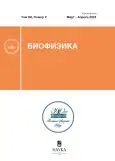On the Role of Priming in the Development of Modern Rehabilitation Technologies
- Authors: Fedotchev A.I1
-
Affiliations:
- Institute of Cell Biophysics, Russian Academy of Sciences
- Issue: Vol 69, No 2 (2024)
- Pages: 399-403
- Section: Articles
- URL: https://journals.rcsi.science/0006-3029/article/view/257591
- DOI: https://doi.org/10.31857/S0006302924020231
- EDN: https://elibrary.ru/OTFDFL
- ID: 257591
Cite item
Full Text
Abstract
About the authors
A. I Fedotchev
Institute of Cell Biophysics, Russian Academy of Sciences
Email: fedotchev@mail.ru
Pushchino, Russia
References
- Бакулин И. С., Пойдашева А. Г., Лагода Д. Ю., Супонева Н. А. и Пирадов М. А. Перспективы развития терапевтической транскраниальной магнитной стимуляции. Нервные болезни, 4, 3–10 (2021).
- Keller C. J., Huang Y., Herrero J. L., Fini M. E., Du V., Lado F. A., Honey Ch. J., and Mehta A. D. Induction and quantification of excitability changes in human cortical networks. J. Neurosci., 38 (23), 5384–5398 (2018). doi: 10.1523/JNEUROSCI.1088-17.2018
- Бакулин И. С., Пойдашева А. Г., Забирова А. Х., Супонева Н. А. и Пирадов М. А. Метапластичность и неинвазивная стимуляция мозга: поиск новых биомаркеров и направлений терапевтической нейромодуляции. Анналы клинич. эксперим. неврологии, 16 (3), 74–82 (2022). doi: 10.54101/ACEN.2022.3.9
- Hassanzahraee M., Zoghi M., and Jaberzadeh S. How different priming stimulations affect the corticospinal excitability induced by noninvasive brain stimulation techniques: a systematic review and meta-analysis. Rev. Neurosci., 29 (8), 883–899 (2018). doi: 10.1515/revneuro-2017-0111
- Haslacher D., Nasr K., Robinson S. E., Braun Ch., and Soekadar S. R. A set of electroencephalographic (EEG) data recorded during amplitude-modulated transcranial alternating current stimulation (AM-tACS) targeting 10-Hz steady-state visually evoked potentials (SSVEP). Data Brief, 36, 107011 (2021). doi: 10.1016/j.dib. 2021.107011
- Liu B., Yan X., Chen X., Wang Y. and Gao X. tACS facilitates flickering driving by boosting steady-state visual evoked potentials. J. Neural Eng. 18 (6), 066042 (2021). doi: 10.1088/1741-2552/ac3ef3
- Goldsworthy M. R., Vallence A. M., Yang R., Pitcher J. B., and Ridding M. C. Combined transcranial alternating current stimulation and continuous theta burst stimulation: a novel approach for neuroplasticity induction. Eur. J. Neurosci., 43 (4), 572–579 (2016).
- Hordacre B., Goldsworthy M. R., Vallence A. M., Darvishi S., Moezzi B., Hamada M., Rothwell J. C., and Ridding M.C. Variability in neural excitability and plasticity induction in the human cortex: A brain stimulation study. Brain Stimul., 10, 588–595 (2017). doi: 10.1016/j.brs.2016.12.001
- Zrenner B., Zrenner C., Gordon P. C., Belardinelli P., McDermott E. J., Soekadar S. R., Fallgatter A. J., Ziemann U., and Müller-Dahlhaus F. Brain oscillationsynchronized stimulation of the left dorsolateral prefrontal cortex in depression using real-time EEG-triggered TMS. Brain Stimul., 13 (1), 197–220 (2020). doi: 10.1016/j.brs.2019.10.007
- Frase L., Mertens L., Krahl A., Bhatia K., Feige B., Heinrich S. P., Vestring S., Nissen Ch., Domschke K., Bach M., and Normann C. Transcranial direct current stimulation induces long-term potentiation-like plasticity in the human visual cortex. Transl. Psychiatry, 11 (1), 17 (2021). doi: 10.1038/s41398-020-01134-4
- Jannati A., Oberman L. M., Rotenberg A., and Pascual-Leone A. Assessing the mechanisms of brain plasticity by transcranial magnetic stimulation. Neuropsychopharmacology, 48 (1), 191–208 (2023). doi: 10.1038/s41386-022-01453-8
- Zhang J. J., Bai Z., and Fong K. N. Priming intermittent theta burst stimulation for hemiparetic upper limb after stroke: A randomized controlled trial. Stroke, 53 (7), 2171–2181 (2022). doi: 10.1161/STROKEAHA.121.037870
- Germann M., Maffitt N. J., Poll A., Raditya M., Ting J. S. K., and Baker S. N. Pairing transcranial magnetic stimulation and loud sounds produces plastic changes in motor output. J. Neurosci., 43 (14), 2469–2481 (2023). doi: 10.1523/JNEUROSCI.0228-21.2022
- Germann M. and Baker S. N. Evidence for Subcortical Plasticity after Paired Stimulation from a Wearable Device. J. Neurosci. 41 (7), 1418–1428 (2021). doi: 10.1523/JNEUROSCI.1554-20.2020
- Liu Y., Liu S., Tang C., Tang K., Liu D., Chen M., Mao Z., and Xia X. Transcranial alternating current stimulation combined with sound stimulation improves cognitive function in patients with Alzheimer’s disease: Study protocol for a randomized controlled trial. Front. Aging Neurosci., 14, 1068175 (2023). DOI: 10.3389/ fnagi.2022.1068175
- Черенкова Л. В. и Соколова Л. В. Зрительный прайминг у детей с расстройствами аутистического спектра. Клиническая и специальная психология, 11 (2), 192–209 (2022). doi: 10.17759/cpse. 2022110109
- Sanders P. J., Thompson B., Corballis P. M., Maslin M., and Searchfield G. D. A review of plasticity induced by auditory and visual tetanic stimulation in humans. Eur. J. Neurosci., 48 (4), 2084–2097 (2018). doi: 10.1111/ejn.14080
- Perenboom M. J. L., van de Ruit M., Zielman R., van den Maagdenberg A. M. J. M., Ferrari M. D., Carpay J. A., and Tolner E. A. Enhanced pre-ictal cortical responsivity in migraine patients assessed by visual chirp stimulation. Cephalalgia, 40, 913–923 (2020). doi: 10.1177/0333102420912
- Савчук Л. В., Полевая С. А., Парин С. Б., Бондарь А. Т. и Федотчев А. И. Резонансное сканирование и анализ электроэнцефалограммы при определении зрелости корковой ритмики у младших школьников. Биофизика, 67 (2), 354–361 (2022). doi: 10.31857/S0006302922020181
- Fedotchev А., Parin S., and Polevaya S. Resonance Scanning as an Efficiency Enhancer for EEG-Guided Adaptive Neurostimulation Life, 13 (3), 620 (2023). doi: 10.3390/life13030620
- Полевая С. А., Парин С. Б. и Федотчев А. И. Сочетание ЭЭГ-управляемой адаптивной нейростимуляции с резонансным сканированием в коррекции стрессиндуцированных состояний и когнитивной реабилитации студентов университета. Бюл. эксперим. биологии и медицины, 175 (6), 710–714 (2023). doi: 10.47056/0365-9615-2023-175-6-710-714
- Федотчев А. И., Полевая С. А. и Парин С. Б. Эффективность ЭЭГ-управляемой адаптивной нейростимуляции увеличивается при оптимизации параметров предшествующего резонансного сканирования. Физиология человека, 49 (5), 17–24 (2023). doi: 10.31857/S0131164623600039
Supplementary files










